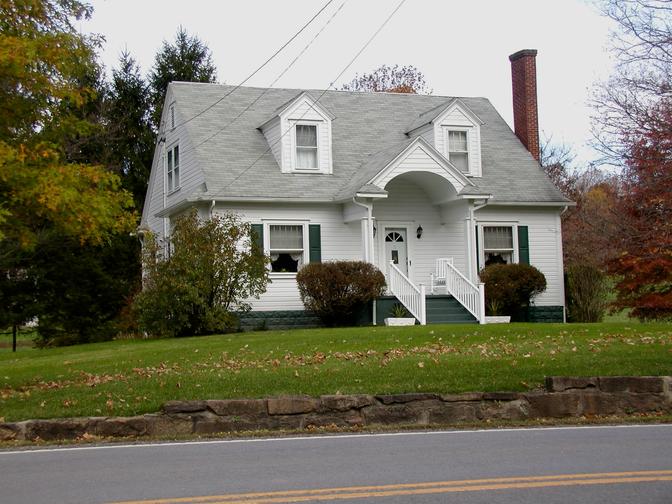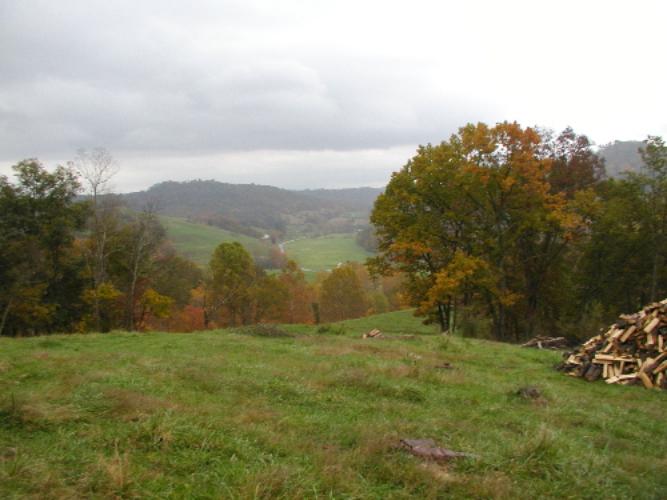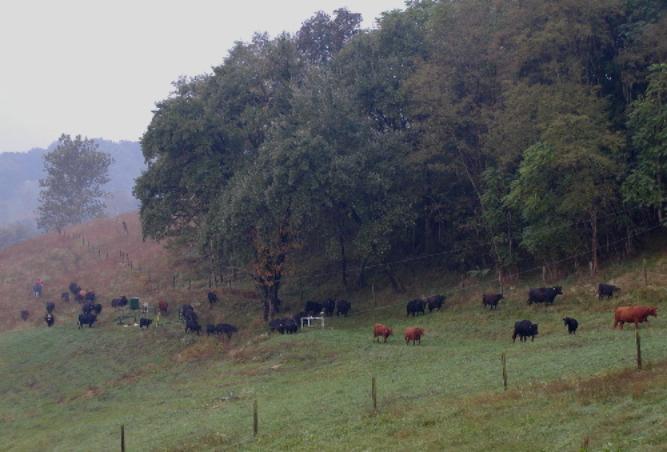
| Next Chapter | Previous Chapter | |
| Chapter 24: Danger from Animals | Contents | Chapter 22: Cuttin’ Filth |
A widely circulated maxim in farming circles is "farming is the most dangerous occupation." We have had our share of accidents. My grandfather, T. M. Bond, died from a fall down the silo at the end of the big barn in 1933. Clifford Jackson hinted to me that it was done to get the insurance money. You've heard the stories of the Wall Street brokers jumping out their windows at that time. Others may have thought so, too, but I can't agree with him. However, it was a serious error in judgment to try to crawl across a board 35 feet up in the air.
The old wooden silo still stood when I was a child. It had a roof, unlike more recent silos. Grandfather tried to cross from the side with the doors used to unload the silo, the side adjacent to the barn, to a window where the blowpipe from the cutter came inside. That board broke.
Aunt Lotta and Dad were the heirs: Aunt Lotta got the insurance money and built a new house, Dad got the farm, and it wasn't paid off until WWII. My grandfather was something of a businessman. His name appears many times in the County Clerk's record of land transactions in Harrison County, and he worked in the sand and gravel business in Salem. He had taken a yearlong Business course at Alfred University in New York. I doubt that building a new house was what he had in mind; surely the insurance was to pay off the farm. Everybody with any business sense knew they were in a bubble in the 20's, and granddad must have been trying to secure the farm. Aunt Lotta's house was very fine in the middle of the depression, and Dad was in debt, often panic, the rest of his life. The farm was paid off in WWII, but he died owing $660 in 1966, the first Farm Credit loan he had not insured. He once told me, "I can't give you much, but I can give you good credit. Take care of it."
There was a booklet published by West Virginia University Extension Service on how the ornamental plantings were to be done around a house. A picture of Aunt Lotta's house was on the front. Aunt Lotta and Dad knew Earl Core, who was head of the Biology Department at WVU. I remember seeing the booklet, but it is not in the trunk Aunt Lotta left behind.
(Illustration 23-1)

The house Aunt Lotta built as it appeared in 2006
A horse was involved in Dad's death. Ward Maxson was married to my sister Lou at the time, and he and Dad had bought a young horse that was not properly broken. Dad was pretty stiff with age, but he liked to ride the horse. He went through the gate behind Aunt Lotta's house, leading the horse, then mounted it. The horse took a step forward as he swung up, and Dad came down behind the saddle, which frightened it, and it bolted. Dad went on the ground on his back, and the horse stepped on his chest, breaking some ribs, one of which punctured a lung.
He seemed to be getting better for two days, then he had a heart attack. The physician had ordered Dad not to have any medicine except the medicine he had prescribed. Dad took digitalis regularly, which the doctor didn't know or ignored, and Dad didn't survive without it. Later we found out that the physician had a track record of that sort of thing. It was before the day of suing incompetent doctors.
So, there are many kinds of danger, but this section is mainly concerned with life and limb. I have described my experience with silos above. Another experience as a child: Dad had a disc harrow when I was about eight which had a wheel like a steering wheel about waist high, to adjust the set of the discs. The steel discs were about a foot in diameter, nine or ten inches apart and thin and sharp. These were designed so that the concave side of the disc in the front tier were turned out, and in the back tier were turned in. The purpose of this wheel was to advance the outer edges of the front tier, and push back the outer edges of the rear tier to get the right depth of cut into the soil.
One day Dad had all three of us kids to take care of. He put one of my sisters on one fender of the 8N, and the other sister on the other fender. I rode the disc with my bare feet on bars and holding on to the wheel. The field was the bottom where Grandfather Kennedy lived as a boy, a couple of hundred yards up stream from the intersection of Davisson Run Road with the West Milford-Lost Creek road, at Righter where the old covered bridge stood. Several hours into the job I was sleepy and the right side of the disc ran over a rock about the size of a gallon jug. My right foot was raised up off the bar, because I was thrown to the left. When it came back down it didn't hit the bar and went on to the ground. The girls saw and tried to stop Dad, but before he could stop my foot went under a disc.
When it came out I had a cut well into the foot. Dad picked me up and we went to Dr. Pletcher's office. I held the sides of the cut together so it would not bleed so much on the way. Dr Pletcher found no tendons cut, it was just short of that, but there were three rows of stitches one in next to the bone, one in the middle and one at the outside, for the skin.
(Illustration 23-2)

Vista up Jesse Run in late Summer Firewood cut by Tim Tucker
I must have been gassed by carbon monoxide from the exhaust. I remember many times in the years I was a teenager riding a side delivery rake behind the tractor, and being very, very sleepy. It wasn't until the rake was long gone that I learned about carbon monoxide making you sleepy. Fortunately, since the body produces minute quantities of it in normal metabolism, the body has a system for eliminating carbon monoxide. The body has no system to eliminate some poisons, like mercury, and these poisons accumulate and get worse as more and more of the poison is added to the body. Carbon monoxide normally does not accumulate in the system, but is eliminated. The elimination system can be overwhelmed, however, by inhaling too much carbon monoxide, and that is what happens when you are exposed to exhaust from an engine.
All of our kids have had some near misses. Paul was driving the 2640 John Deere through McWhorter on the way from the Lost Creek farm to the Jesse Run farm. About three or four hundred yards south from the railroad crossing nearest Lost Creek, the one mentioned above where my Dad met the train on his Fordson, he pulled over on the berm to give someone else more road. He went over the edge of the railroad cut, which had an angle of about 50 to 60 degrees from horizontal, down some twelve feet. The tractor went over the bank and came to rest on its side without turning over. Fortunately, Paul stayed in the seat.
He crawled off, and pretty soon Hugh Davis came along with his John Deere. Hugh is a family friend (his Dad was in the silage cutter co-op mentioned above), a long time farmer and pretty knowledgeable about machinery, and a good guy. He hooked a chain on to Paul's tractor in such a way as to prevent it from turning it over, and pulled it to the next crossing, where it came right out. It didn't even need to go to the dealer for repairs, but it was a very near miss for Paul. Very lucky he didn't get hurt or killed.
When Ward Maxson, my former partner, owned the Ray Smith place, Paul was coming up the road from the barn to the top of the hill behind Betty's house and got off it in the gully that runs down to the stone house. A steep and precarious place. The tractor stuck but didn't turn over, but another close call.
When Charlita was very small, she was helping us bring cattle in around the hill from pasture to the lot behind the house so we could work on them. In the narrow spot below the locust grove, she was
(Illustration 23-3)

Cattle coming in to the chute
pushing on a calf, not much larger than the calf itself. We were all close together, but the mother cow dashed through and knocked her over, and jumped completely over her. She cried but was only slightly bruised.
Alan was driving the tractor on the Smith place once and it caught on fire. He was wearing a hard hat (we were almost unique in wearing hard hats among the farmers of our area, Jack Shock, a colorful figure about whom I will have more to say later, is the only other I can think of who wore one). Alan got off the tractor immediately to run down to a small pond about fifty yards away. When he was coming back up the hill with a hat full of water, the best he could do, the tractor, one of our Ford 3000's, drifted off the hill, going at one point about forty vertical feet in twelve horizontal feet, through a fence. The fire blazed up so much it alarmed the neighbors and they called the fire department. Farm Family Insurance (Farm Bureau) declared the tractor a complete loss. Not so close for Alan, but close enough.
The worst story is the one involving Kurt. I am ashamed to tell it, because my judgment was so bad, nearly causing a disaster. The company that took out our limestone used in I-79 agreed to dig out for a basement garage behind the existing house. They had loaders (called "front end loader" then) large enough to be efficient in moving the alluvial soil the house sits on. They agreed to put the dirt in the pond across the road until the road began to show the effect of crossing. When it did they put the rest of the dirt in the yard to the side of what was to be our new drive way.
This had to be leveled out with our 8N Ford tractor and a "blade" behind it. (This was before we had a loader on our farm tractors.) There was somewhat of a problem using the blade, because it wasn't heavy, didn't have a good way to add weight to it, and wouldn't shave off much dirt at a time. I solved the problem by having Kurt, about eight, drive the tractor, and I would ride the blade.
This worked quite well for a while, but on one turn he got the tractor in a higher gear, or the surface was so hard the blade didn't dig in the way it should have and the tractor got to going too fast. I saw Kurt bounce up so his bottom was at the level of the steering wheel, and he started to go forward, off the right side. I immediately started forward, over the blade and tractor hitch. Kurt must have taken another bounce or two before he went off, but I was in the seat as soon as he left it. Kurt ended up with his right arm extended under the right rear wheel of the tractor, up to the shoulder, and his head twisted up hard against the wheel.
In retrospect, several things helped. The ground was soft enough, and the wheel soft enough (about 12 pounds per square inch), and the tractor light enough so his arm did not receive loads that would break it. And my reflexes and "cool under fire" got it stopped in time - just the nick of time!
I am not as athletic as my father, to his considerable disappointment, but when there is only one simple set of facts to concentrate on, not so many as in a basketball game, I can do fairly well. I want to include one other story, personal, not farm, which is worth injecting at this point.
When Esther and I were at Kent, working on the Ph. D. in Chemistry, we liked to go up to Lake Erie. It was severely polluted, but a large body of water was of considerable interest to folks from the hills, and folks from the cities of north Ohio, hot in summer, too, judging by the four lane road that led to the state park we visited.
It had a long, broad beach and always a lot of visitors. One evening about an hour before dark the crowd had thinned out, and Paul, Kurt and I were in the water with Esther and Alan on the beach. Kurt was so small he needed my constant attention. Paul was heading out to deeper water. I kept an eye on him, and all of a sudden his head disappeared. I had to get Kurt back to the beach, twenty yards or so, then go out to where Paul was at thirty or forty yards. Fortunately his head came back up, giving me something to guide on. He had taken in a lot of water but was basically sound. He spent the night in the hospital.
Where were the life guards? Three of them were talking, within 20 yards of Esther all the time. They caught on after I started back in with Paul, and helped then, rather late.
While we are on accidents, few words about hard hats, which have saved a lot of minor accidents on this farm. Jack Shock, who lived across the hill toward McWhorter started wearing the old aluminum style hard hat before I did. I don't know what motivated him. He had been a machinist in Akron for the aircraft industry for several years and doubtless wore one at work.
One day I was cutting trees around what we have always called the "Godfrey Meadow," not because Kenny ever owned it, but because it is near his house. I was cutting a thorn tree with the chain saw and it came down, sticking a thorn in my head so hard I could not pull it out and had to go to the house and have Esther pull it out. I resolved that some one was sending me a message, and began to wear the aluminum hard hat.
The only time I was injured by a hard hat was during the period of the aluminum hard hat. I had an electric fence along the road west of the house and needed to get electricity over to the fence below the locust grove. I put a pole in the road fence line and brought it diagonally down to the woods fence. One evening at dusk, on a very hot day when the bands on the interior were saturated with sweat, I walked into the diagonal connection. That is the only time I remember actually seeing stars. I have frequently been hit by the electric fence, but that was the worst I ever got. Some of the charge must have gotten to my brain.
Shortly after, Jack and I, along with many others, were fighting "Hope Gas" (actually Consolidated Gas Transmission) and various other gas and electric utilities for the way they ran over land owners. They favored the "Safety V" plastic hard hats - white for the bosses and yellow for the workers. Jack and I started wearing white plastic hard hats at that time, and I continue now, long after Jack's death, and require it and hearing protection for all my workers who drive tractors or use chain saws.
Aside What did we talk about when we worked? When I was young, many men often worked together in the field making hay or silage. We talked about the past, about people, stories about animals that had done something unusual, a little about politics. Telling stories was a natural art form practiced by everyone. By the time I was a teenager, silage was gone, and Papaw, Uncle Gene and I made stacks of hay, while Dad brought it in from the windrows with a tractor. Conversation was more restricted, since we didn't have workmen that were not with the family, as we had earlier. Today all field work is solitary, with so much engine noise you couldn't have a decent conversation anyway.
We do work together, my sons and I, with cousin Gene Kennedy sometimes, or cousin Adam Bond and occasionally others, when we are "working" cattle. My cattle get more immunizations each year than my children did in their whole lives. (Of course, the children lived in much more sanitary environment, and were not exposed to wild animals, which have a number of diseases domestic animals get.)
Working cattle requires a lot of verbal communication, so there isn't much story telling. Paul and Kurt are both computer programmers, so they have endless conversations about programming methods, when they can, just like they do at other times. James and I and the rest talk about our families and such other work as we do. There is no oral tradition of the past left.
| Next Chapter | Previous Chapter | |
| Chapter 24: Danger from Animals | Contents | Chapter 22: Cuttin’ Filth |
Copyright © 1998, 2006, 2008, 2011 S. Tom Bond (stombond at hughes.net)